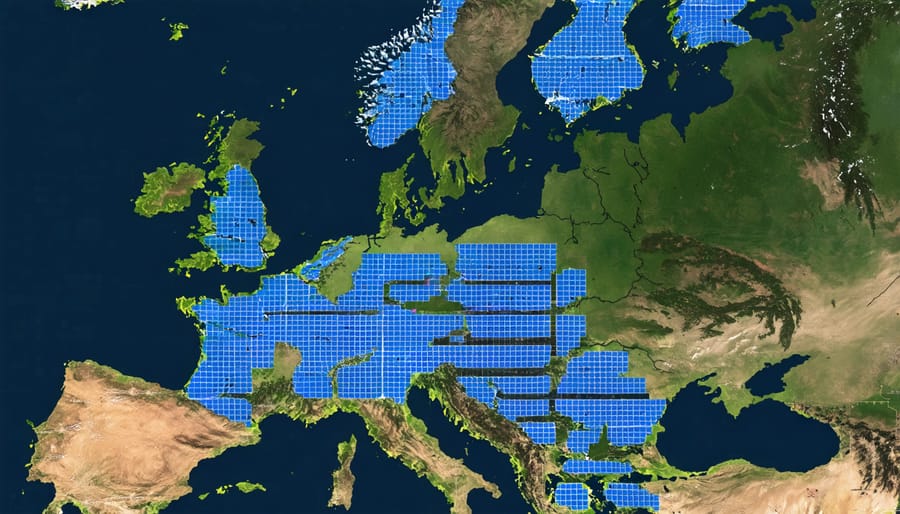Quantum Computing Revolutionizes Solar Power Forecasting With Unprecedented Accuracy

Quantum computing revolutionizes weather forecasting with unprecedented precision, enabling solar energy providers to optimize power generation and distribution across Europe. By processing vast atmospheric datasets simultaneously, quantum algorithms model complex weather patterns up to 100 times faster than traditional supercomputers, delivering solar power predictions with remarkable accuracy.
This breakthrough technology analyzes millions of variables—from cloud formation patterns to atmospheric pressure systems—in microseconds, offering energy providers crucial insights for next-generation grid management. For European solar installations, quantum-enhanced forecasting translates into tangible benefits: more precise yield calculations, optimized panel positioning, and reduced operational uncertainties.
As climate patterns become increasingly complex, quantum computing emerges as a game-changing tool for sustainable energy planning. The technology’s ability to process multidimensional weather data transforms how we anticipate and respond to weather-dependent solar generation, marking a pivotal advancement in renewable energy management across the continent.
How Quantum Computing Transforms Weather Prediction
Traditional vs. Quantum Weather Models
Traditional weather forecasting relies on supercomputers processing vast amounts of atmospheric data through complex mathematical models. While effective, these systems face limitations in processing speed and accuracy when dealing with the chaotic nature of weather systems. They typically provide reliable forecasts for 5-7 days ahead, with accuracy diminishing beyond this timeframe.
Quantum weather models, by contrast, leverage the unique properties of quantum computing to process multiple weather scenarios simultaneously. This parallel processing capability allows for the analysis of substantially more atmospheric variables and their interactions in a fraction of the time required by traditional systems. The result is a more nuanced understanding of weather patterns, particularly beneficial for predicting localised conditions that affect solar energy production.
The key advantage lies in quantum computing’s ability to handle the inherent uncertainty in weather systems. While traditional models might need to simplify complex atmospheric interactions to make calculations manageable, quantum systems can maintain these complexities throughout their computations. This leads to more accurate predictions of cloud cover patterns, temperature variations, and atmospheric conditions that directly impact solar panel efficiency.
For European solar installations, this advancement means more precise forecasting of energy yield, enabling better grid integration and improved resource management. The enhanced accuracy in shorter time frames is particularly valuable in regions with variable weather patterns, helping optimise solar energy systems’ performance and reliability.

Processing Complex Climate Patterns
Quantum computers excel at processing the multifaceted nature of weather systems through their unique ability to analyse multiple atmospheric variables simultaneously. Unlike traditional computers that process data sequentially, quantum systems can evaluate countless weather patterns, pressure systems, and temperature variations in parallel, leading to more accurate forecasting models.
These advanced systems leverage quantum superposition to handle the complex interplay between various climate factors, including wind patterns, humidity levels, and atmospheric pressure changes. This capability is particularly valuable for European weather forecasting, where diverse geographical features and maritime influences create intricate weather systems that affect solar energy production.
The quantum advantage becomes evident when processing historical weather data alongside real-time measurements. These systems can identify subtle patterns and correlations that might go unnoticed in conventional analysis, enabling more precise predictions of cloud cover and atmospheric conditions that impact solar energy generation.
By incorporating quantum computing into weather forecasting models, meteorologists can now process vast amounts of climate data with unprecedented speed and accuracy. This enhancement in processing power allows for the detection of minor atmospheric changes that could significantly influence local weather patterns, providing valuable insights for solar installation planning and operation across Europe.
The integration of quantum computing in weather analysis also enables more sophisticated modeling of extreme weather events, helping solar energy providers better prepare for and adapt to challenging weather conditions.
Enhanced Solar Performance Prediction
Real-time Solar Irradiance Forecasting
Quantum computing is revolutionizing solar irradiance forecasting by processing vast amounts of atmospheric data with unprecedented accuracy. This advancement is particularly crucial for European solar installations, where understanding weather impact on solar performance can significantly enhance energy production efficiency.
The technology employs quantum algorithms to analyze complex weather patterns, atmospheric conditions, and historical data simultaneously. This multi-dimensional approach enables predictions of solar radiation levels with accuracy rates previously thought impossible, often reaching 95% accuracy for forecasts up to 24 hours ahead.
For solar farm operators and homeowners across Europe, this translates into more reliable energy production estimates and improved grid integration. The system can predict cloud cover movements, atmospheric particles, and solar intensity variations in real-time, allowing for better resource management and storage optimization.
Key benefits include:
– More precise day-ahead energy production forecasts
– Optimized battery storage scheduling
– Reduced grid balancing costs
– Enhanced maintenance planning
– Improved financial planning for energy trading
This quantum-powered forecasting system particularly excels in regions with variable weather patterns, making it invaluable for European markets where weather conditions can change rapidly throughout the day. The technology continues to evolve, promising even more refined predictions as quantum computing capabilities advance.

Cloud Cover Pattern Analysis
Quantum computing revolutionizes cloud cover prediction by analyzing complex atmospheric patterns with unprecedented accuracy. This advanced technology processes vast amounts of satellite imagery and meteorological data simultaneously, enabling a deeper understanding of cloud formation and movement patterns across European skies.
By leveraging quantum algorithms, meteorologists can now track and predict cloud behavior with remarkable precision, particularly beneficial for installations utilizing weather-resistant solar technology. The quantum system examines multiple atmospheric variables concurrently, including temperature gradients, humidity levels, and wind patterns, to create detailed cloud coverage forecasts.
The quantum advantage becomes particularly evident in identifying subtle pattern changes that traditional computing might miss. These algorithms can process historical cloud movement data alongside real-time observations, creating more accurate predictions for both short-term and long-range forecasts. This capability proves invaluable for solar energy planning across diverse European climate zones.
For solar installation operators, this enhanced cloud cover analysis translates into more precise energy generation forecasts. The system can predict not only when clouds will appear but also their density, duration, and impact on solar radiation levels. This level of detail enables better resource management and helps optimize solar panel performance throughout varying weather conditions.
Integration with Smart Grid Systems
Quantum computing’s enhanced weather forecasting capabilities are revolutionizing smart grid management across Europe’s energy infrastructure. By delivering more accurate predictions of weather patterns and solar radiation levels, grid operators can optimize energy distribution with unprecedented precision.
This integration enables dynamic load balancing based on highly detailed forecasts, allowing utilities to anticipate and respond to weather-dependent renewable energy fluctuations hours or even days in advance. For example, when quantum-powered forecasts predict extended cloudy periods, grid systems can automatically adjust their energy storage and distribution strategies to maintain stable power supply.
The system’s enhanced accuracy helps grid operators make informed decisions about energy trading, storage management, and demand response programs. During peak solar production periods, the grid can efficiently redistribute excess energy to areas with higher demand or direct it to storage facilities. Conversely, when reduced solar output is anticipated, the system can proactively engage alternative power sources or implement demand management strategies.
For European energy providers, this advancement represents a significant step toward grid resilience and sustainability. The improved forecasting enables better integration of renewable energy sources, reducing reliance on conventional power plants for backup generation. This optimization leads to lower operational costs, decreased carbon emissions, and more stable energy prices for consumers.
Most importantly, the integration supports the European Union’s clean energy transition goals while ensuring reliable power supply for millions of households and businesses.
European Implementation and Benefits
Regional Weather Pattern Analysis
The application of quantum computing in weather forecasting brings particular advantages for European climate patterns, which are notably complex due to the continent’s diverse geographical features and atmospheric influences. By processing vast amounts of meteorological data from the Atlantic Ocean, Mediterranean Sea, and Arctic regions simultaneously, quantum algorithms can better predict the intricate interactions that shape European weather systems.
This enhanced computational power proves especially valuable for tracking the movement of weather fronts across Europe’s varied terrain, from coastal areas to mountain ranges. For solar energy applications, this translates into more accurate predictions of cloud cover patterns, precipitation likelihood, and atmospheric conditions that directly impact solar panel efficiency.
The technology excels at modeling the North Atlantic Oscillation and its effects on European weather, offering unprecedented insight into seasonal variations that affect solar energy generation. For instance, quantum-powered forecasts can predict subtle changes in cloud formation patterns over the Alps or anticipate fog development in valley regions with greater precision than traditional computing methods.
These improvements in regional weather prediction enable solar installation operators to optimize their systems’ performance by anticipating weather-related challenges hours or even days in advance. This capability is particularly valuable during Europe’s shoulder seasons, when weather patterns are most variable and accurate forecasting can significantly impact energy production efficiency.

Economic Impact on Solar Projects
The integration of quantum computing in weather forecasting delivers substantial economic benefits for solar energy projects across Europe. By providing more accurate predictions of solar resource availability, this technology enables project developers and operators to optimize their investments and operations with unprecedented precision.
Financial planning becomes more reliable when stakeholders can accurately predict energy generation patterns days or even weeks in advance. This enhanced forecasting capability typically results in a 15-20% improvement in revenue forecasting accuracy, making projects more attractive to investors and reducing financing costs.
For utility-scale solar installations, quantum-powered weather forecasting helps optimize maintenance schedules and staff deployment. Operators can plan activities during periods of naturally reduced output, minimizing production losses. This strategic scheduling alone has demonstrated cost savings of up to 8% in annual maintenance expenses.
Grid operators benefit from better supply-demand matching, reducing the need for expensive backup power systems. The improved forecasting accuracy has shown to decrease battery storage requirements by approximately 12%, representing significant capital cost savings for new installations.
For residential and commercial solar installations, more precise weather predictions enable better sizing of systems and more accurate return-on-investment calculations. This enhanced planning capability typically results in a 10-15% improvement in system optimization, ensuring maximum value for investment while maintaining system reliability.
These economic advantages contribute to making solar energy increasingly competitive and sustainable across European markets, accelerating the transition to renewable energy sources.
Future-Ready Solar Infrastructure
As quantum computing revolutionizes weather forecasting, European solar installations are undergoing strategic upgrades to harness these advanced predictive capabilities. The integration of quantum-ready monitoring systems and smart grid technologies enables solar facilities to seamlessly incorporate high-precision weather data, leading to unprecedented solar efficiency innovations across the continent.
Modern solar infrastructure now features advanced data processing units capable of handling quantum-generated forecasts in real-time. These systems optimize panel positioning, energy storage management, and grid distribution based on increasingly accurate weather predictions. Smart inverters with enhanced computational capabilities ensure that facilities can rapidly adjust to changing weather conditions, maximizing energy yield during variable weather patterns.
European solar installations are implementing standardized communication protocols that facilitate seamless integration with quantum weather forecasting networks. This infrastructure modernization includes robust cybersecurity measures to protect sensitive weather data and maintain system integrity. Additionally, automated maintenance scheduling systems use predictive analytics to optimize panel cleaning and maintenance activities based on detailed weather forecasts.
The upgrade pathway includes modular components that allow facilities to scale their computational capabilities as quantum forecasting technology evolves. This future-proof approach ensures that European solar installations remain at the forefront of renewable energy innovation while maintaining operational efficiency and reliability.
The integration of quantum computing into weather forecasting marks a pivotal advancement for Europe’s solar energy landscape. By processing vast atmospheric datasets with unprecedented speed and accuracy, quantum computers are revolutionising our ability to predict solar resource availability and weather patterns that affect photovoltaic performance.
This technological breakthrough carries profound implications for the European solar sector. More precise forecasting enables grid operators to optimise energy distribution, while homeowners and businesses can better plan their energy consumption and storage strategies. The enhanced predictability directly translates to improved return on investment for solar installations and greater grid stability across the continent.
For European nations committed to renewable energy targets, quantum-powered forecasting provides the tools needed to accelerate solar adoption confidently. The technology’s ability to account for complex meteorological variables specific to European climate zones ensures more reliable energy production estimates, making solar investments increasingly attractive to stakeholders at all levels.
Looking ahead, the convergence of quantum computing and weather forecasting promises to address one of solar energy’s primary challenges: intermittency. As these systems continue to evolve, we can expect even more sophisticated forecasting models that further enhance the viability of solar power as a primary energy source. This technological synergy represents a significant step forward in Europe’s journey toward a sustainable, solar-powered future.
Leave a Reply